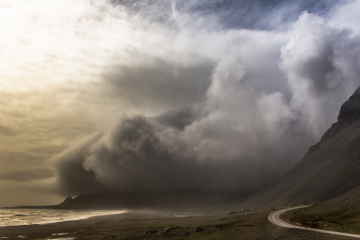700823_Williwaws_360 px width.png

When cold, dense air sinks it can accelerate due to gravity along the sides of mountains and create powerful gusts at the bottom, known as williwaws. These katabatic winds can create hurricane force winds and cause damage to boats and buildings. Credit: Buiobuione, CC BY-SA 4.0.
In early 1945, as World War II neared its climax, 19-year-old Gore Vidal was the first officer of an Army supply ship in the Aleutian Islands of Alaska. The weather was often stormy. Another ship in the fleet was hit by an especially nasty type of wind storm. Vidal wrote his first novel about his time in the Aleutians, and incorporated that storm into the plot. In fact, he named the novel after the wind: Williwaw.
In scientific parlance, a williwaw is a type of katabatic wind. Such winds plunge down the sides of mountains, roaring outward when they hit level ground. They’re found all over the world. And they have many names. The warm, dry wind of Southern California, for example, is called a “Santa Ana.” In Alaska, British Columbia, and off the tip of South America, though, they’re known as williwaws.
A williwaw begins as dense, cold air atop a mountain slides to lower elevations, accelerated by gravity. When it reaches the bottom of the mountain, the wind blows along the coastline and out to sea. And it’s something that no mariner wants to see coming.
Williwaws produce powerful gusts. The strongest recorded in Alaska hit almost 140 miles per hour—the equivalent of a category four hurricane. The winds rattle buildings, rock boats in port and near the coastline, and can even capsize boats. When a williwaw is in the forecast, a vessel might add extra mooring lines, drop a second anchor, or even head to sea to stay out of its way—avoiding the fury of a williwaw.

